Talk
to anyone who has been to India and you’ll find it’s like Marmite – they either
loved it here or hated it. I don’t like Marmite.
Landing
in Chennai our experience of India kicked off exactly as it would continue. We queued
at the desks marked e-tourist visa and waited an age for each person to be
processed. Biometrics had to be taken, but these guys made the US border
control seem slick. Unsurprisingly in a country with so many formalities and
rules, several people in the queue ahead of us had issues and were sent off to
complete various tasks. We’d nonchalantly not bothered to get our e-visa
confirmations printed, but this didn’t seem to be a problem. Eventually we were
through and we set off in search of the free tourist SIM cards we had been told
were available from multiple airport kiosks. Not true. After half an hour of
searching we gave up and caught a bus into town for 5p. If India has one thing
going for it, it’s cheap.
Seemingly another omen of the type of experience
we were going to have in India, I managed to drop my phone during our SIM card
search, not breaking the screen itself, but causing a bleed that by the time we
reached the city centre covered half the screen, making it unusable. First
tasks – to find a place to stay and a screen repair shop. The latter proved
easy enough and two hours and £55 later my phone was functioning again. A room
for the night was more of a challenge. The first place we booked turned out not
to exist, the second required that we sign the official secrets act, complete a
questionnaire that all but asked for the colour of our underwear and have our
photo taken before we were presented with a room key. The room was basic, comfortable
enough, but certainly not inspiring. It’s fair to say our first impressions of
India were pretty grim. On a plus point, we’d earlier managed to find black
market SIM cards at a little roadside kiosk, quite by chance, so we at least
had google to help us navigate and research where we might want to go next.
Our first full day in India started out pretty
well. With the help of an Indian guy on a forum we had established that there is
a whole street full of secondhand motorbike dealers in Chennai, so we made our
way there and indeed, we had plenty to choose from. For the majority of people
looking to ride around India, there’s only one bike that fits the bill – the Royal
Enfield Bullet – but this wasn’t what we were looking for. Despite reservations
about their weight, we had been pretty well set on Enfield’s too until we
watched a documentary made by two American guys as they rode around the country
on them and were horrified at how easily they buckled under even the lightest
pressure. A very minor off for one of the guys resulted in both the crash bars
and the gear change lever bending, both of which it was possible to bend back into
shape easily by hand.
Royal Enfield’s dismissed, our criteria was quite
simple – to buy bikes that are reliable and easy to fix, are common models that
local people ride and are as comfortable as possible to sit on for several
hours at a time. After spending a day looking at various options, we found just
the thing – Honda Unicorns. Ok, maybe we were swayed by the name just a little.
150cc, common as muck and well, they’re Honda’s right? Enough said. After
nearly a whole day of looking we had roughly earmarked some to try the next day
and set off to find the helmet district.
The following day, armed with our shiny new
helmets, we set off for Bridge Street, determined to return with our bikes,
only to find that by this time we’d completely forgotten which ones we had
liked the look of. Eventually I found a bike I liked for a price that was
within budget and from a dealer who wasn’t a condescending asshole, something I
came across quite a lot on that street. Now we just had to come up with a second
bike for Evan. For the next couple of hours we sat while the dealer, our new
best friend scoured the street for Unicorns until a whole parade of them awaited
our test drive. By early afternoon we had two tidy looking bikes selected, each
with near brand new tires and after a series of negotiations on the price and a
few little repairs, we were good to go. Two bikes for 65,000 rupees, around £850.
We were ready to leave the big, bad city.
It’s not actually possible to legally own a
motorbike as a foreigner in India so we had no paperwork to deal with. Instead,
we made sure that the bikes came with all the paperwork we would require in
order to sell them on again when we’re finished with them, signed by the
current owner, as well as proof of insurance. For the time they’re in our
possession we’ll simply to ‘borrowing’ them from their registered owner. It all
sounds very simple, and in reality it was. Day three in India and we had bikes
and we were ready to roll. In hindsight, had we known what lay ahead, the road
conditions, the cultural attitudes and the sheer bloody mindedness of local
people, would we have chosen India to spend our winter in this year? Probably
not, but them hindsight is a wonderful thing. The following day we set off out
of Chennai, south bound.
 |
| Here's hoping that this isn't a sign of things to come... |
 |
| Typical state of our feet after a few hours walking in the city in sandals! |
Leaving Chennai was a relief. I remember riding
that first day trying to think of even one good thing about that city, but drew
a complete blank. Chennai is a dirty, smelly, mostly unfriendly city. Pollution
is so high that a continuous smog hangs in the air. During the daytime, when
the sun is high in the sky, the stench as you walk its streets reaches a
nauseating high. People openly urinate and defecate in the street here. Add to
this the traffic fumes, rotting food waste and copious amounts of cow dung and you
have something that you have to experience to believe.
Our first destination was Pondicherry, an old
former French colonial settlement on the east coast, but now a Union territory
in its own right that had been recommended to us by a couple of people as
somewhere we shouldn’t miss. Although we didn’t realise it at the time, this
town would set the tone for so much of our trip over the next few weeks.
Arriving in Pondicherry (or Puducherry as it is also called – everywhere in
India has at least two different names for the same place which makes following
road signs all the more difficult) we rode around for a while trying to figure
out what exactly it was that we were supposed to be there for. It was an average
town, with average looking buildings and people with a similar attitude to
those we had left in Chennai. Now late in the day, we found a cheap place to
stay on Agoda, only to arrive there and find that we were not welcome to stay –
Indian nationals only, no foreigners. This wouldn’t be the last time we
received the same welcome. We eventually found a room in a place that was
equally as hospitable, right next to the bus station where buses blared their
horns all night and the reception staff made it perfectly clear that they were
not at all happy with the work we were causing them in having to register us.
The ride to Pondicherry is worthy of a mention
too. Now, we have ridden bikes all over the world at this point, but never have
we ridden anywhere where road users have so little regard for anyone else on
the road. I’m not just talking people taking silly risks here, I mean total and
utter disregard for everyone else to the point where people will run you off
the road and over a cliff in an attempt to assert their dominance. And it’s
damn tiring. Riding in a foreign country is anyway by its very nature, but this
is on a whole new level.
Power is king here. Buses rule the road. Apart
from ambulances of course, which are the most psychotic of all – I guess they
have to drum up business. Trucks can also do whatever they damn well please on
account of their crushing ability. Cars dominate bikes. Bikes dominate
pedestrians. Cows are sacred so they trump everything. Cows also assert their
power over dogs. Dogs over cats. Cats over rats. You get the picture. And every
single person goes out of their way to make sure no-one below them is allowed
to gain an inch. Add to the mix that 90% of drivers are disgustingly
misogynistic males, who, when overtaken by a white foreign woman on a 150cc
motorbike while they’re piddling along the line between the second and third
lanes at 30km, turn into murderous demons, intent to catch and teach you a
lesson for your nerve, and you can appreciate that the roads in India are a
pretty scary place. And I’m not just talking about a few isolated incidents
here, I’m talking all day every day. I don’t have enough fingers and toes to
count the number of seriously dangerous incidents we have encountered each and
every day we have been riding.
That said, we have also encountered a handful
of redeeming meetings with local people that have gone a small way to restoring
our faith in this place. On the way to Pondicherry we stopped at the Motorcycle
Diaries café, a cute little themed place run by a group of local guys. While we
ate our chicken burgers and potato wedges the owner very kindly made us a huge
list of all the places we should see in Kerala and Karnataka as we headed south
and then north again up the west coast. It’s meeting people like this that
keeps us sane, keeps us moving and prevents us from dumping our bikes by the side
of the road and catching a tuk tuk to the nearest airport.
Our next stop was a surprisingly pleasant
place, a little town called Muttapathi. We arrived at our guesthouse to find
that there was no-one there, as is so often the case in India. We sat around,
waited, waited some more and were eventually met by a very friendly guy who
bent over backwards to make sure everything was to our satisfaction. It turned
out that we’d arrived on the eve of the first day of the Pongal festival, a
harvest festival only celebrated in Tamil Nadu. All day we had ridden through
small villages where families by the car load were collecting lengths of sugar
cane and bundles of turmeric from roadside vendors and now we knew what this
was for. That evening we learned a little more about the festival from the
local people, ate freshly cooked samosas and drank coffee at a little roadside
shop. A local leather worker kindly punched a new hole in Evan’s belt for him
and then flatly refused payment. A local guy now living in England but visiting
family went out of his way to come and talk to us, giving us his number and
telling us that if there was anything we needed we should call him. For the
first time we felt like we were somewhere that was happy enough with our
presence.
Aware now that the Pongal festival was quite a
spectacle in some parts, we decided the next day to head for Rameshwaram, a
small town towards the end of the peninsula to which Sri Lanka would join if
there was a land connection. We were lucky enough to find a cheap enough room
despite warnings that these sold out months in advance and spent the day watching
locals and pilgrims carrying out various rituals associated with Pongal, most
notably bathing in the holy river, after which they must discard their old
clothes and wear new ones bought especially for the occasion. Fascinating to
watch, but on account of the state of the water, we didn’t participate. The
cows laying on the beach seemed to enjoy the show too.
Before leaving town we made time for a quick
visit to the end of the peninsula to visit the ghost town of Dhanushkodi, a
community swept away by a cyclone in the 60’s. Ironically, despite the fact
that no-one lives there now, the 30km stretch of road leading to it is freshly
laid tarmac, still one of the best roads we have seen in India. A little
disappointingly, but not really surprisingly, we arrived to a barrage of noise
and vendors selling seashells clearly imported from elsewhere right up to and
inside the ruins, entirely killing any atmosphere that might have existed
otherwise. We returned to our bikes and continued our quest to find at least one
place that had the wow factor, that made us glad we were there.
Our next big stop was Kanyakumari, on the most southerly
tip of India. We found a very cheap room in a house owned by a lovely local
lady who took the time to chat with us about our trip and our lives. She told
me about her daughter and how troubled she was that she only had one child and
appeared not to be able to have any more, despite much trying. Her confusion
when I explained to her that I had none, nor wanted any was palpable.
We spent a day here wandering through the huge
waterside market, visiting the place where Gandhi’s ashes were held for some
time after his death and took a ferry trip across to the huge Vivekananda Rock
Temple on an island in the bay. To celebrate the end of our first 1000km
without dying we ordered fried fish for dinner from a little local eatery and
promptly got chana masala and a chapatti, despite a local guy with good English
confirming our order with the waiter after there was some earlier confusion.
Food has been a sticking point pretty much
everywhere we’ve been in India. Occasionally we get what we ordered, but most
of the time we don’t, even when there appears to be no communication issue at
all. Indians are famous for not wanting to disappoint and say no when they don’t
have something, so I think a lot of the time they just bring an alternative to
what you asked for instead and hope you don’t mind. One of the biggest
bug-bears though is the request for ‘NOT spicy please’. A request for no chili,
not spicy, however you want to phrase it has a very different meaning to what
you’d expect. ‘Not spicy’ to the average Indian chef means you only want four
teaspoons of chilis in your dinner rather than the requisite five. The concept
of no chili at all just doesn’t compute. This means that at regular intervals
we find ourselves craving awful things like KFC or McDonalds or Dominoes –
well, we did until we discovered that virtually everything on the menu at these
places has been Indianised. In addition McDonalds doesn’t use any beef products
and Burger King’s innovative way round this of offering a Mutton Whopper just
doesn’t hit the spot.
The next few days involved stops in mostly
unmemorable towns. We swung by Kovalam beach on the south coast on account of
the Indian restaurant in Brightlingsea run by a family from there. The next
place on our ‘must see’ list would be a hill station called Ponmudi. Reaching
it involved a surprisingly enjoyable ride along a winding forest road for
around 60km, through 22 hairpin bends that would have been much more fun if it
weren’t for the piles of loose grit and sand on almost every corner. Road
surfaces here are not bad on the whole, but there is a tendency for the
condition to change at a moments notice from smooth new tarmac to potholed,
grit covered skid pan and back again so you always have to be on your toes.
Ponmudi Hill Station was an interesting enough
place. It was hot and humid so we decided to throw caution to the wind and
leave our bags and helmets on our bikes and climbed up to a concrete viewing tower
high up on a hill, only to find that because of poor construction it was
wrapped with long lengths of barbed wire to prevent people climbing for safety
reasons. After admiring the views we decided to make our next stop a slightly
more unusual one – a sculpture high on a hilltop claiming to be the largest
bird sculpture in the world.
It was further than we anticipated and took us
longer than we expected to reach the small town of Chadayamangalam where the sculpture
was situated. It was mid afternoon when we arrived, but still we stopped for
tea at a little roadside shack before riding the last couple of kilometres up
the hill, a decision that in hindsight allowed the following extraordinary
sequence of events to line up in a way they wouldn’t otherwise have done.
The climb to the top of the hill was a steep
one, a gravelly track possible only in first gear. At the top we reached a
barrier manned by a serious looking guard who informed us bluntly that we could
go no further, that the sculpture was not finished and was on a private resort
property. No, we could not proceed. Disappointed, we had no option but to turn
around and descend back from where we had just come. At the bottom of the hill
we paused to figure out where we were going to go next and in doing so blocked
the entrance way for a jeep that was trying to access the lane. Annoyed, as it
is so often the case here that people on four wheels simply want to be wherever
you are sitting just in order to make you move, we reluctantly shifted to the
side.
At this point the driver pulled over and exited
the vehicle, before coming over to us and asking if we’d like to see the sculpture?
He explained that he was the project manager for the site and was happy to show
us around! We followed his vehicle back up the hill, smugly passing the guard
at the barrier who looked a little bemused to see us again, before parking at
the top on the sites brand new helipad. At this point the project manager,
Jayaprakash, introduced the other people in his car – Indian film director
Rajiv Anchal, who had the original inspiration for the project, Boby Chemmanur,
an actor, Kerala businessman, gold dealer and charity worker as well as the
architect and sculptor of the eagle itself. Our timing couldn’t have been any
better.
Over the next few hours we toured the
not-yet-finished exclusive VIP retreat area of the resort, which when open will
only allow twelve guests to stay at a time, as well as the cable car station
and of course the eagle sculpture itself. To say this place is a feat of engineering
is an understatement. The sculpture itself has been under construction for more
than 8 years already. Built entirely of concrete, the materials have been
painstakingly, manually winched up the hill and the concrete mixed by hand, one
small bowl at a time before being added to the sculpture be a team of local
workers. JP explained to us the legend behind the sculpture.
In Hindu mythology, Jatayu is a demi-god in the
form of an eagle. In the epic story ‘Ramayana’, Jatayu witnesses Ravana (a
powerful king with ten heads) trying to abduct Sita (a goddess and daughter of
the earth goddess Bhumi) from her husband Lord Rama. A fight ensues, during
which Ravana manages to chop off one of Jatayu’s wings causing him to drop,
dying, on to the hilltop on which the sculpture now sits. Therefore the eagle sculpture
has only one wing and the eagle lies on his back, symbolic of Jatayu’s last
moments. Standing on Jatayu’s wing looking up at his head it’s hard to describe
the sheer wonder of this project. More was still to come though as we were led
inside, up through rooms where projections and art installations are planned,
to the eagles head where we watched as the sun set over the surrounding valley.
At last, we had our ‘WOW’ moment.
Thanking our hosts profusely for their
generosity in allow us to join them for the afternoon, we set off just as the
sun dropped into the smog on the horizon to ride the 30km or so to Varkala
Beach, the closest place we could see that might have accommodation for the
night. Arriving after dark we had no idea that we had landed in tourist town, a
beautiful beach resort town on the top of a cliff. We settled into our little
bamboo hut room, still buzzing from our afternoon’s luck.
The next couple of days we went full-on
tourist, spending time on the beach, eating very good non-Indian food, drinking
mojitos and browsing the tourist-tat shops for things we really didn’t need. I’m
not usually a fan of touristy places, but it was the perfect antidote to the
stress of riding here every day. We even found proper branded suncream and
toilet paper for sale. At last, things seemed to be looking up!



















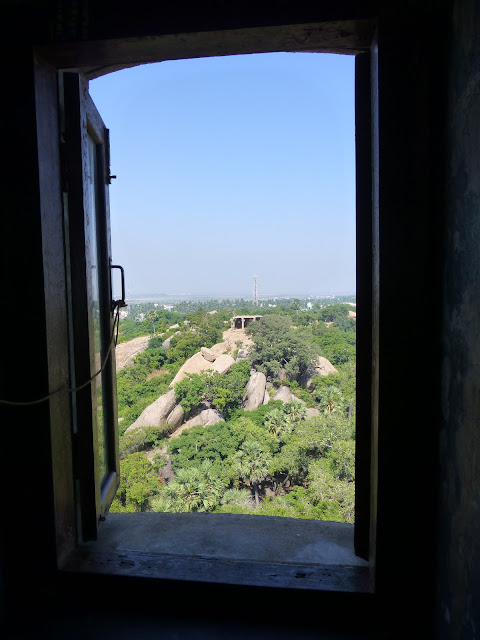








































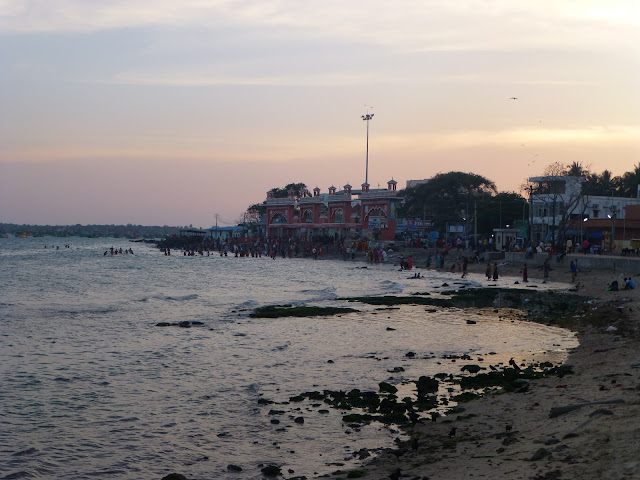
































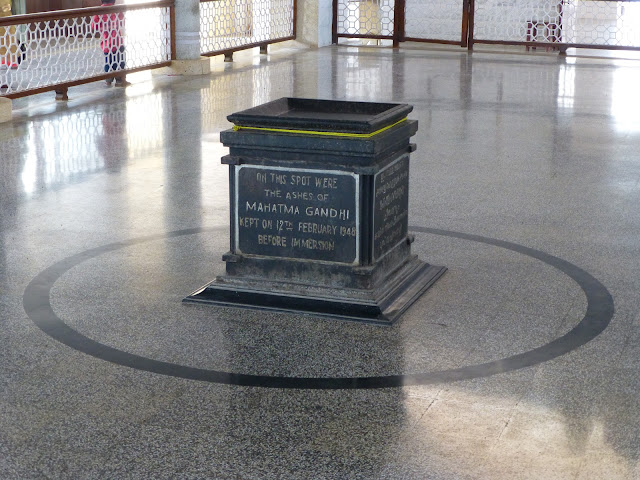

















































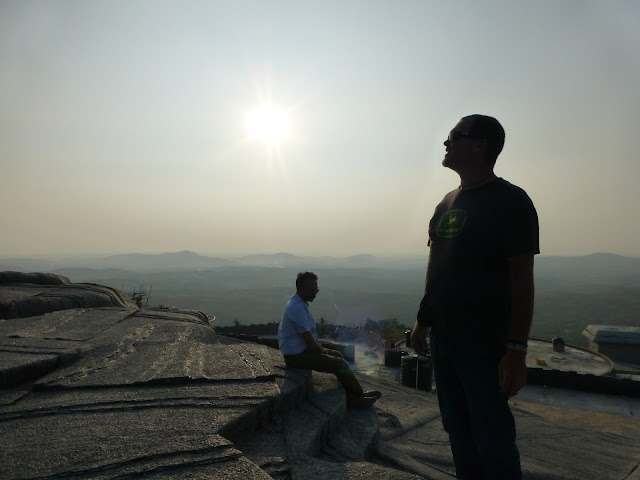


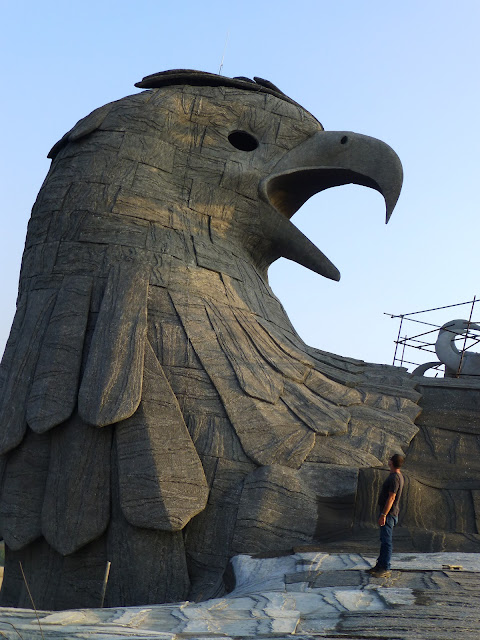








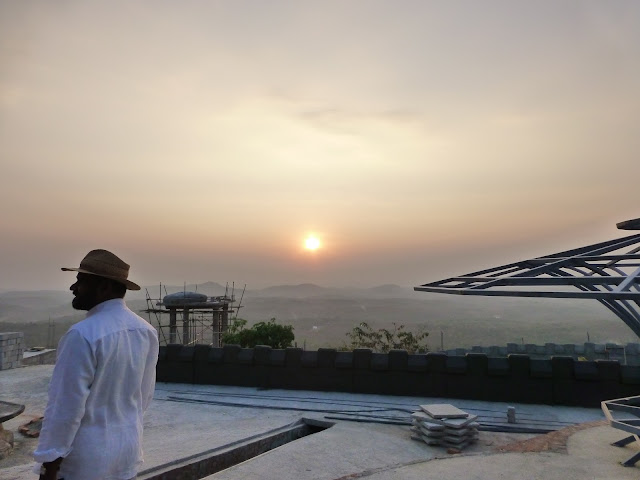























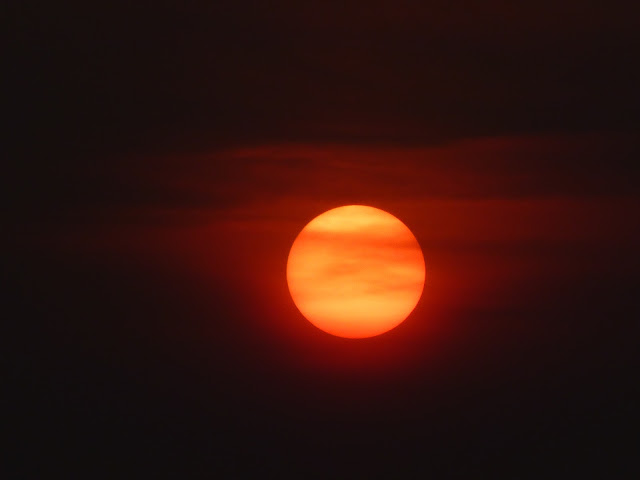
wow Caroline I just love the story of the eagle. That sculpture will be fabulous when it's finished. I understand how you must feel about India, a young friend thought it was really uninteresting and unfriendly too. I'm enjoying reading about your journey. xxx
ReplyDelete